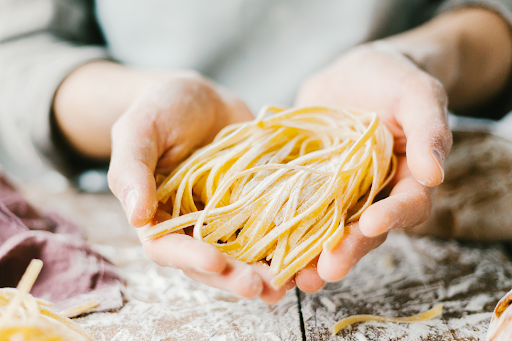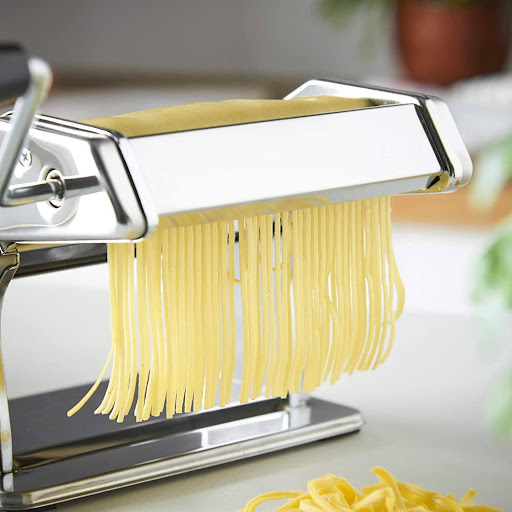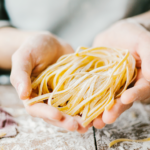Who doesn’t love a good pasta dish? It’s a worldwide favorite, and if you’re a fan of cooking, love experimenting, or maybe have Italian roots, chances are you’ve tried making pasta from scratch. It’s fun, but let’s be honest, sometimes we all get a bit carried away and end up with more pasta than we need for just one meal. So, what do you do with all that extra pasta? Simple – save it for later! In this guide, we’re going to show how to store homemade pasta so that it’s fresh and ready for your next delicious recipe.
How to Store Fresh Pasta: A Step-by-Step Guide
So, you’ve made more pasta than you can eat in one sitting. No problem! You’ve got three great options for storing fresh pasta: drying, freezing, and refrigerating. Let’s break down each method step-by-step:
Method 1: Dry It

Drying pasta is a classic method. It’s ideal if you don’t plan to use your pasta right away and want to keep it handy in your pantry.
How to Dry Fresh Pasta:
- Start by laying your pasta out on a clean, dry surface. Use a pasta drying rack if you have one, or just lay it flat on a clean kitchen towel or a baking sheet.
- Make sure there’s enough space between the strands or pieces of pasta. Good airflow helps them dry evenly.
- Drying pasta takes time. Depending on the thickness, it could take anywhere from a few hours to a full day. You’ll know it’s ready when the pasta is completely dry and snaps easily.
- Once dried, store your pasta in an airtight container or a zip-top bag. Keep it in a cool, dry place.
Tip: When drying pasta, do it at room temperature in a well-ventilated area. Direct sunlight or heat can cause the pasta to dry unevenly or become too brittle.
Method 2: Freeze It
Freezing is your ideal method if you’re not planning to use your pasta within the next month or so.
How to Freeze Fresh Pasta:
- To freeze fresh pasta, lay it out on a baking sheet lined with parchment paper. Again, make sure the pieces aren’t touching.
- Pop the tray in the freezer for about 30 minutes. This ‘flash freezing’ stops the pasta from sticking together later.
- After the pasta is firm, transfer it to a freezer bag or an airtight container.
- Don’t forget to label your container with the date.
Tip: When you’re ready to eat, there’s no need to thaw – just cook it directly from frozen, adding a minute or two to your usual cooking time.
Method 3: Refrigerate It
If you’re planning to use your pasta within a couple of days, refrigeration is the way to go.
How to Refrigerate Fresh Pasta:
- Toss your pasta with a little bit of flour to prevent sticking. This step is especially important for longer pasta like spaghetti or linguine.
- Place your pasta in an airtight container or a resealable plastic bag. If you’ve made a lot, consider dividing it into portions for easier use.
- Store the container in the fridge.
Note: If you’ve already mixed your pasta with sauce, you can refrigerate it using the same method.
How Long Does Fresh Pasta Last?
The shelf life of your pasta depends on the storage method you choose.
If you’ve gone the drying route, your pasta becomes pretty much like the store-bought dried pasta. In an airtight container, it can last up to two weeks in your pantry. Just make sure it’s completely dry before storing it to avoid any mold growth.
If you prefer freezing fresh pasta, you’ve hit the jackpot in terms of shelf life. Frozen pasta can last up to three months without losing its quality. Just make sure it’s stored in a freezer-safe container or bag. This is a great option if you’re into meal prep or if you don’t plan to use your pasta right away.
If you’ve chosen to store your pasta in the fridge, it’s best to use it within two to three days. This method is ideal if you made a bit too much for dinner and are planning a pasta meal in the next day or two. If you’ve mixed your pasta with sauce or you’ve made cooked pasta, the same time frame applies.
How to Check If Your Fresh Pasta Has Gone Bad

Even with the best storage methods, fresh pasta dough can go bad. Here are some tips to check for freshness:
- Check the Color: Fresh pasta should maintain its natural color. If you notice any discoloration, like a grayish or yellowish tinge, it’s a sign that your pasta might not be good to eat anymore.
- Smell It: Trust your nose! If the pasta has an off or sour smell, it’s time to toss it. Fresh homemade pasta should have a neutral or slightly flour-like aroma.
- Look for Mold: This is a clear indicator that your pasta has gone bad. Mold can appear as fuzzy spots in various colors. If you see any mold, it’s best to discard the pasta.
- Check the Texture: If the pasta feels slimy or overly sticky, it’s a sign of spoilage. Fresh pasta should be relatively firm and not have a slimy coating.
- Taste Test: If you’re still unsure, taste a small piece. If the pasta tastes sour or off in any way, it’s better not to eat it.
Summary
If you want to store homemade fresh pasta, you have three options: drying, freezing, and refrigerating. Drying makes it ready to cook anytime. Freezing is for long-term storage, and refrigerating works great if you plan to make a pasta meal within the next few days.
Speaking of homemade pasta, have you tried MisterChef’s Pasta Maker? With its user-friendly design and multiple features, making freshly cooked pasta at home has never been easier. Shop with us today.






